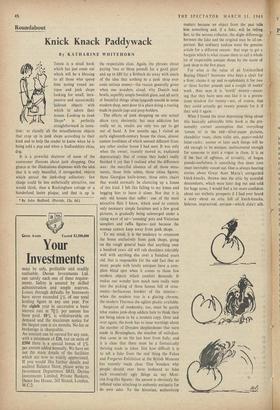Roundabout
Knick Knack Paddywack
By KATHARINE WHITEHORN
THERE is a small book which has just come out which will be a blessing to all those who spend time nosing round an- tique • and junk shops looking for small, inex- pensive and occasionally hideous objects with which to adorn their homes. Looking in Junk Shops* is perfectly straightforward in inten- tion: to classify all the miscellaneous objects that crop up in junk shops according to their kind and to help the reader to know when he is being sold a pup and when a Staffordshire china dog.
It is a powerful shatterer of some of the commoner illusions about junk shopping. One glance at the illustrations dispenses with the idea that it is only beautiful, if unregarded, objects which attract the junk-shop collectors: few things could be less aesthetically attractive, one would think, than a Rockingham cottage or a Sunderland lustre plaque, and that is up in * By John Bedford. (Parrish, 12s. 6d.) the respectable class. Again, the phrases about paying 'two or three pounds for a good plate' and up to £80 for a fireback do away with much of the idea that nothing in a junk shop ever costs serious money—the reason generally given when one wonders, aloud, why Danish teak bowls, superbly simple Swedish glass, and all sorts of beautiful things often languish unsold in some modern shop, next door to a place doing a roaring trade in puzzle jugs and posy-holders.
The effects of junk shopping on any actual decor vary, obviously; but once addiction has really set in, results are only too apt to get out of hand. A few months ago I visited an early eighteenth-century house the clean, almost austere loveliness of which seemed different from any other similar house I had seen. It was only when the owner, recently moved in, explained deprecatingly that of course they hadn't really finished it yet that I realised what the difference was: the merciful absence of all those orna- ments, those little tables, those china figures, those Georgian knife-boxes, those extra chairs that would normally be cluttering up a house of this kind. I felt like falling to my knees and begging him to leave it alone. Not that it is only old houses that suffer: one of the most attractive flats I know, which used to contain only necessary simple furniture and a few good pictures, is gradually being submerged under a rising wave of tat—'amusing' pots and Victorian samplers and raffia figures—just because the woman cannot keep away from junk shops.
To my mind, it is the tendency to ornament the home exclusively from junk shops, going on the rough general basis that anything over a hundred years old will rub shoulders tolerably well with anything else over a hundred years old, that is responsible for the odd fact that so many people with lovely antiques have a com- plete blind spot when it comes to those few modern objects which comfort demands. It makes one wonder how much taste really went into the picking of those houses full of orna- ments—herbaceous borders of the interior— when the modern tray is a glaring chrome, the modern Thermos the ugliest plastic available.
Suspicion of modernity, too, must be partly what makes junk-shop addicts hate to think they are being taken in by a modern copy. Over and over again, the book has to issue warnings about the number of Dresden shepherdesses that were made in Birmingham, the number of milleflore that came in on the last boat from Italy; and it is clear that there must be a fantastically thriving trade in fakes. Just how difficult it is to tell a fake from the real thing the Fakes and Forgeries Exhibition at the BEitish Museum has recently made clear. One 'wonders why people should ever have bothered to fake such excessively ugly things as, say Mexi- can frog-like figures: the answer is obviously the inflated value attaching to authentic antiquity for its own sake. To the historian, authenticity matters because an object from the past tells him something and, if a fake, will be telling lies; to the serious collector, the slight differencp between the fake and the original may be all-im- portant. But ordinary junkies want the genuine article for a different reason : that urge to get a bargain which is what causes them to call a whole lot of respectable antique shops by the name of junk shop in the first place.
For what is the value of an Unidentified Buying Object? Someone who buys a chair for a fiver, cleans it up and re-upholsters it for two or three further pounds and a couple of weeks' work , then says it is 'worth' twenty—mean- ing that they have seen one like it in a preten- tious window for twenty—not, of course, that they could actually get twenty pounds for it if they sold it again.
What I found the most depressing thing about this basically admirable little book is the pre- sumably correct assumption that everything 'comes in' in the end—silver-paper pictures, chandelier vases, china toilet sets, papier-mdché letter-racks: sooner or later such things will be old enough to be antique, undiscovered enough for someone to start a vogue in them. It is as if the fact of ugliness, of triviality, of bogus pseudo-usefulness is something that sheer time must inevitably cancel out. One is always hearing stories about Great Aunt Maria's unregarded knick-knacks, thrown into the attic by scornful descendants, which were later dug out and sold for huge sums; I would feel a lot more confident about our aesthetic prospects if I had ever heard a story about an attic full of knick-knacks; hideous, impractical, antique—which didn't sell.


































 Previous page
Previous page